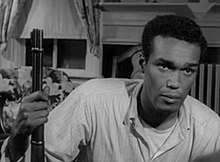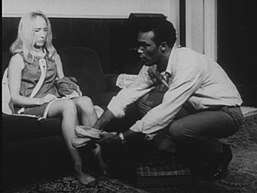Duane Jones
Duane L. Jones (February 2, 1937 – July 22, 1988) was an American actor, best known for his leading role as Ben in the 1968 horror film Night of the Living Dead.[1][2] He was director of the Maguire Theater at the State University of New York at Old Westbury, and the artistic director of the Richard Allen Center for Culture and Art in Manhattan.
Duane Jones | |
|---|---|
 Jones in Night of the Living Dead (1968) | |
| Born | February 2, 1937 New York City, U.S. |
| Died | July 22, 1988 (aged 51) Mineola, New York, U.S. |
| Other names | Duane L. Jones |
| Occupation | Actor, director, teacher |
| Years active | 1968–1988 |
Early life and education
Jones was born to Mildred Gordon Jones. He had a sister, Marva (later Marva Brooks), and a brother, Henry.[3] He went to the Sorbonne and studied acting in New York City.
Early career
From 1972 to 1976, he oversaw the literature department at Antioch College. Jones was also a Phelps-Stokes exchange scholar in Niger and taught literature at Long Island University. He created English-language training programs for the Peace Corps and helped design Harlem Preparatory School, where he headed the English department.[3]
Career

His role in the 1968 movie Night of the Living Dead marked the first time an African-American actor was cast as the star of a horror film, and one of the first times in American cinema where a person of color was given an important role when the script did not explicitly call for one. At the time, casting a black man as the hero of a film where all the other characters were white was potentially controversial. While some saw the casting as significant, director George A. Romero states "Jones simply gave the best audition."
He continued working in film after Night of the Living Dead in Ganja & Hess (1973) and Beat Street (1984), among others.[3] Despite his other film roles, Jones worried that people only recognized him as Ben.[4]
Jones was executive director of the Black Theater Alliance, a federation of theater companies, from 1976 through 1981[3] and continued working as a theater actor and director, until his death in 1988. As executive director of the Richard Allen Center for Culture and Art (RACCA), he promoted African-American theater. He also taught acting styles at the American Academy of Dramatic Arts in New York City. After leaving the American Academy of Dramatic Arts, he taught a select group of students privately in Manhattan, by invitation only. His hand-selected students were of diverse ethnic backgrounds. The students were picked from his Acting Styles classes at American Academy of Dramatic Arts.
Death
Jones died of cardiopulmonary arrest at Winthrop-University Hospital in Mineola, Long Island, New York, on July 22, 1988, aged 51.[3] He was cremated and his ashes given to his family.[5]
Legacy
- The Duane L. Jones Recital Hall at State University of New York at Old Westbury is named after him.[3]
- In the zombie comic book The Walking Dead, one of the characters is named Duane Jones.[6]
Filmography
| Year | Title | Role | Notes |
|---|---|---|---|
| 1968 | Night of the Living Dead | Ben | |
| 1973 | Ganja and Hess | Doctor Hess Green | Also released as "Blood Couple" |
| 1982 | Losing Ground | Duke | |
| 1984 | Beat Street | Robert | |
| 1986 | Vampires | Charles Harmon | |
| 1988 | To Die For | Simon Little | Posthumously released |
| Negatives | Charles Harmon | archive footage from Vampires | |
| 1989 | Fright House | Charles Harmon | archive footage from Vampires, (segment "Abadon"), (final film role) |
References
- Maçek III, J.C. (June 15, 2012). "The Zombification Family Tree: Legacy of the Living Dead". PopMatters. Retrieved August 4, 2018.
- "Interview: George Romero - Film director". Scotsman. Johnston Publishing Ltd. March 6, 2010. Retrieved December 23, 2010.
- Fraser, C. Gerald (July 28, 1988). "Duane L. Jones, 51, Actor and Director of Stage Works, Dies". The New York Times. Retrieved January 24, 2012.
- Jones, Duane (2002). Bonus interviews (DVD). Night of the Living Dead. Millennium Edition. Elite Entertainment.
- Wilson, Scott (September 26, 2016). Resting Places: The Burial Sites of More Than 14,000 Famous Persons (3rd ed.). McFarland Publishing. p. 384. ISBN 9781476625997.
- Davis, Brandon (September 6, 2017). "Robert Kirkman Writes Tribute To 'Walking Dead' Inspiration George Romero". Comic Book. GameSpot. Retrieved August 4, 2018.